Brazilian Army Pvt. Francisco de Paula of the Brazilian Expeditionary Force prepares to load a 105 mm M2A1 howitzer, shoving a shell into the breech of his gun with the inscription “A cobra está fumando" (The snake is smoking) during the Italian Campaign, WWII. 

The BEF consisted of about 25,700 men arranged by the army and air force to fight alongside the Allied forces in the Mediterranean Theatre of WWII. Brazil was the only independent South American country to send ground troops to fight overseas. 
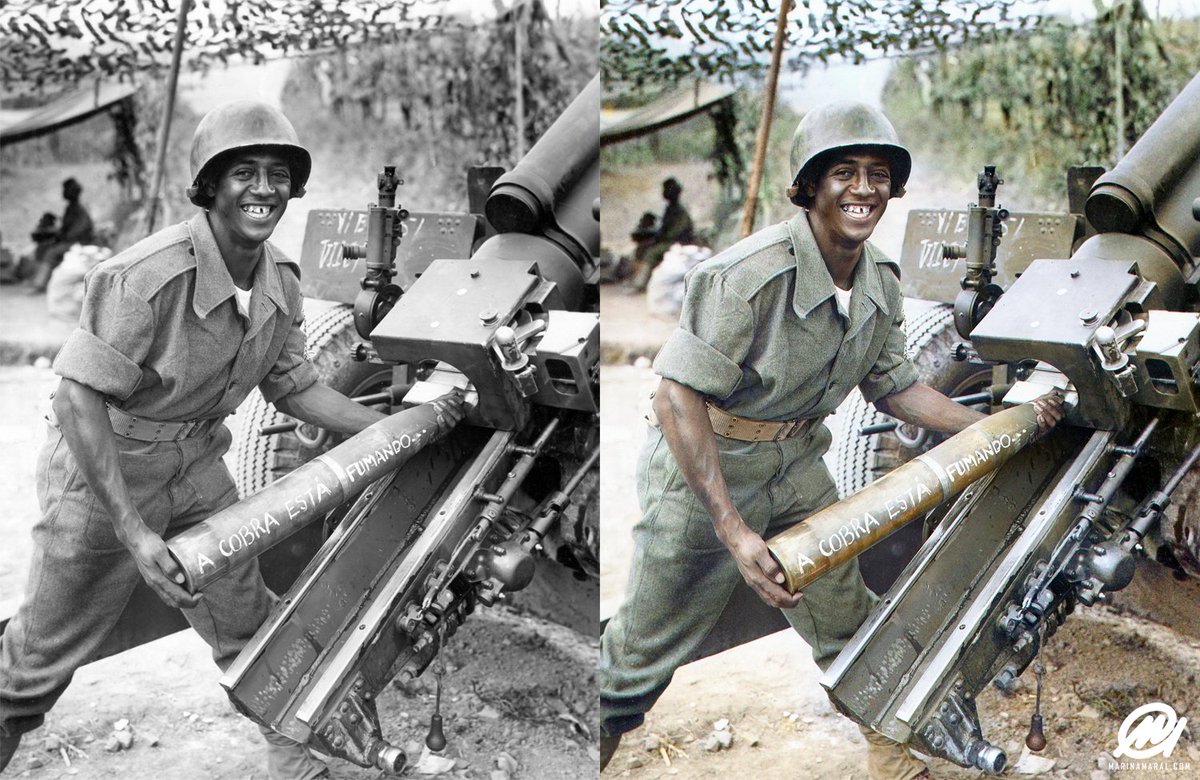
During the almost eight months of its campaign, the BEF managed to take 20,573 Axis prisoners, consisting of two generals, 892 officers, and 19,679 other ranks, losing 948 men killed in action across all three services (Infantry Division, Liaison flight, and a Fighter squadron)
The Brazilian Expeditionary Force fought in Italy from September 1944 to May 1945, while the Brazilian Navy, as well as the Air Force, also acted in the Battle of the Atlantic from the middle of 1942 until the end of the war.
Brazil's participation alongside the Allied powers in WWII was by no means a foregone conclusion, even though Brazil (along with Italy, Japan and Romania) had supported the Triple Entente in World War I.
Brazil in 1939 maintained a position of neutrality, initially trading with both the Allies and the Axis powers. As the war progressed, trade with the Axis countries became almost impossible and the US began forceful diplomatic efforts to bring Brazil onto the Allied side.
These efforts led to the creation of the Joint Brazil-US Defense Commission, which worked to strengthen military ties between the two countries during the war.
It was designed to reduce the likelihood of Axis attacks on US shipping as soldiers traveled across the Atlantic to Africa and Europe, and minimized the influence of the Axis in South America.
At the beginning of 1942, Brazil permitted the US to set up air bases on their territory in return for the offer by the US to encourage the formation of a steel industry - Companhia Siderúrgica Nacional, in Brazil. 
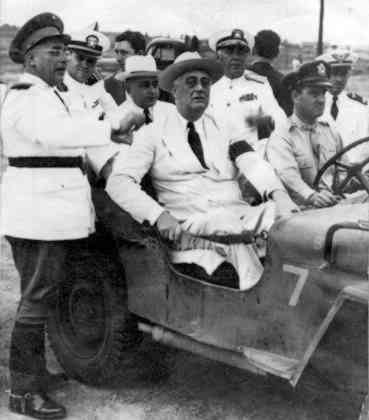
Although Brazil remained neutral, this increasing cooperation with the Allies led the Brazilian government to announce at the Pan American States Conference in Rio, on 28 January 1942, its decision to sever diplomatic relations with Germany, Japan, and Italy.
As a result, from the end of January to July 1942, German U-boats sank 13 Brazilian merchant vessels. In August 1942, U-507 alone sank five Brazilian vessels in two days, causing more than 600 deaths.
In all, 21 German and 2 Italian submarines caused the sinking of 36 Brazilian merchant ships involving 1,691 drownings and 1,079 other casualties. The sinkings were the main reason that led the Brazilian government to declare war against the Axis.
The Brazilian 1st Division of the BEF was subordinate to the Allied 15th Army Group under Field Marshal Harold Alexander, via the US Fifth Army of Lieutenant General Mark Clark and the US IV Corps of Major General Willis D. Crittenberger.
The BEF headquarters functioned as an administrative headquarters and link to the Brazilian high command under the secretary of war, General Eurico Gaspar Dutra in Rio de Janeiro. General Mascarenhas de Morais was the commander of the BEF.
The BEF was (theoretically) organized as a standard US infantry division of that time, complete in all aspects, down to its logistical tail (including postal and banking services), although some of these, like its health services, were found to be deficient... 
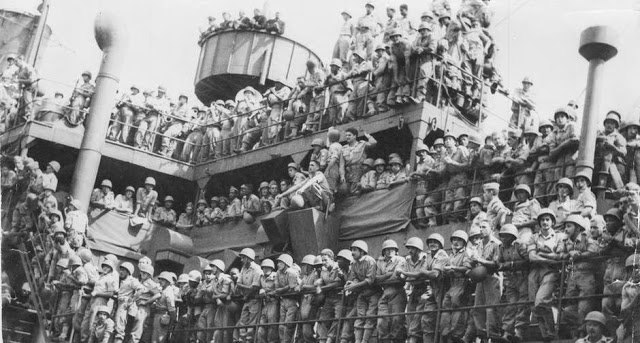
..... and had to be complemented, and in many cases controlled or managed by Americans.
On July 2, 1944, the first five thousand BEF soldiers, the 6th RCT, left Brazil for Europe aboard the USS General Mann, and arrived in Italy on July 16. They disembarked in Naples, where they waited to join the US Task Force 45. 

They had landed without weapons, and since there was no arrangement for barracks, the troops remained on the docks. This caused controversy in the Brazilian media.
In late July, two more ships with Brazilian troops arrived in Italy, with three more following in September and November 1944, and February 1945. One notable unit deployed was Brazil's Mountain Infantry Battalion.
The BEF dedicated its first weeks in Italy to acquire the proper equipment to fight on Italian terrain, and to training under American command. In August, the troops moved to Tarquinia, 350 km north of Naples. In November, the BEF joined General Crittenberger's US IV Corps.
The Brazilians joined what was a multinational hodgepodge of forces. The American forces included the segregated African-American 92nd Infantry Division and the Japanese-American 442nd Infantry Regiment. 

British Empire forces included New Zealanders, Canadians, Indians, Gurkhas, Black Africans, Jews and Arabs from the British Mandate in Palestine, South Africans and Rhodesians, units of exiles—Poles, Greeks, Czechs, Slovakians, as well as anti-fascist Italians...
... all serving under British command. French forces included Senegalese, Moroccans and Algerians.
The BEF achieved battlefield successes at Massarosa, Camaiore, Mount Prano, Monte Acuto, San Quirico, Gallicano, Barga, Monte Castello, La Serra, Castelnuovo di Vergato, Soprassasso, Montese, Paravento, Zocca, Marano sul Panaro, Collecchio and Fornovo di Taro. 

The first missions the Brazilians undertook in close connection with the US 370th RCT, were reconnaissance operations to the end of August. Brazilian troops helped to partially fill the gap left by divisions of the US VI Corps and French Expeditionary Corps... 
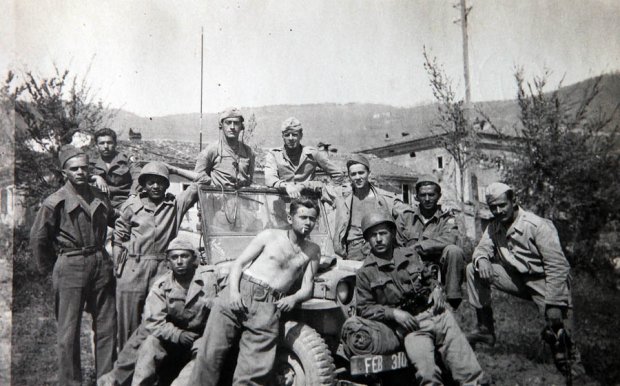
... that left Italy for Operation Dragoon, the invasion of southern France. On September 16, the 6th RCT took Massarosa. Two days later it also took Camaiore and other small towns on the way north.
By then, the BEF had already conquered Monte Prano, and taken control of the Serchio valley without any major casualties. 

Between the end of February and the beginning of March 1945, in preparation for the Spring offensive, the Brazilian Division and the US 10th Mountain Division were able to capture important positions on the Northern Apennines, which deprived the Germans of key artillery positions
in the mountains, whose effective fire had since the fall of 1944 blocked the Allied path to Bologna.
In the US Fifth Army's sector, the final offensive on the Italian Front began on April 14, after a bombardment of 2,000 artillery pieces; an attack carried out by the troops of US IV Corps led by the Brazilian Division took Montese. 

After the first day of the Allied offensive, the Germans, without much effort, had stopped the main attack of IV Corps led by the US 10th Mountain Division, causing significant casualties among the troops of that formation.
The Germans were misled into thinking that the BEF's raid over Montese, using M8 armoured cars and Sherman Tanks, could be the real main Allied objective in that sector, which led them to shell the Brazilians with 1,800 artillery rounds from the total of 2,800 used against all..
... four Allied divisions in that sector during the days of the battle for Montese, when they tried unsuccessfully to take it back from the Brazilians. 
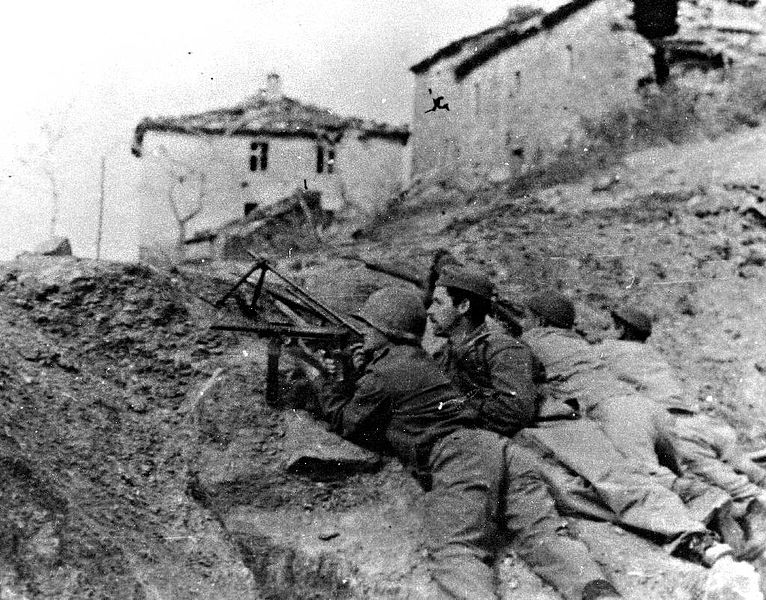
After that, the breaking of the Germans' lines to the North by forces of IV Corps became unavoidable. On the right, the Polish Division, from the British 8th Army, and the US 34th Infantry Division, from Fifth Army, entered Bologna on 21 April. 
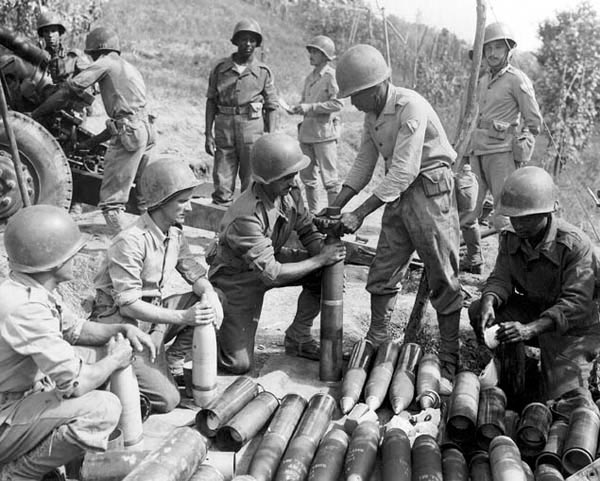
On 25 April the Italian resistance movement started a general partisan insurrection at the same time as Brazilian troops arrived at Parma and the Americans at Modena and Genoa. The British 8th Army advanced towards Venice and Trieste.
At the Battle of Collecchio, Brazilian forces were preparing to face fierce resistance at the Taro river region from the retreating German-Italian forces in the region of Genoa/La Spezia that had been set free by troops of the 92nd US Division.
On April 28, the Brazilians captured more than 13,000 men, including the entire 148th Infantry Division, elements of the 90th Panzergrenadier and the Italian 1st 'Italia' Bersaglieri Division. 
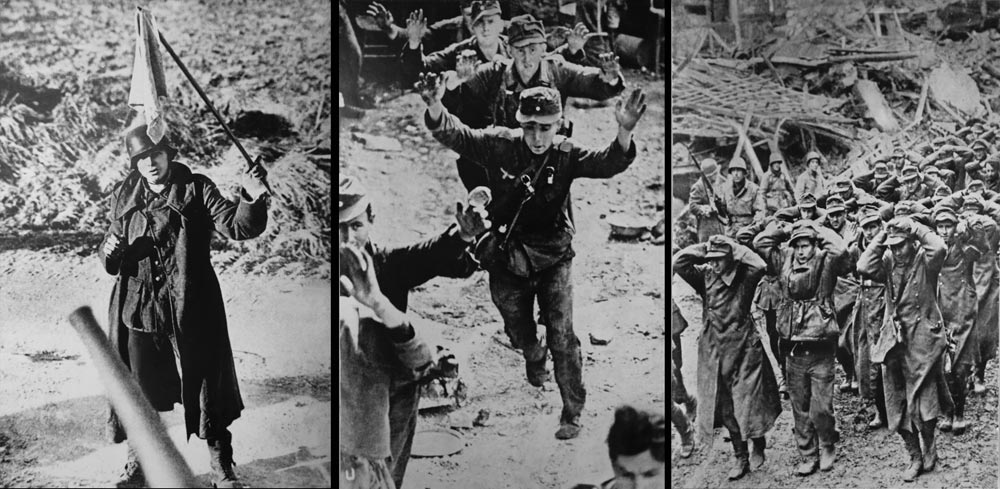
This took the German Command by surprise as it had planned for these troops to join forces with the German-Italian Army of Liguria to counterattack against the Fifth Army. 
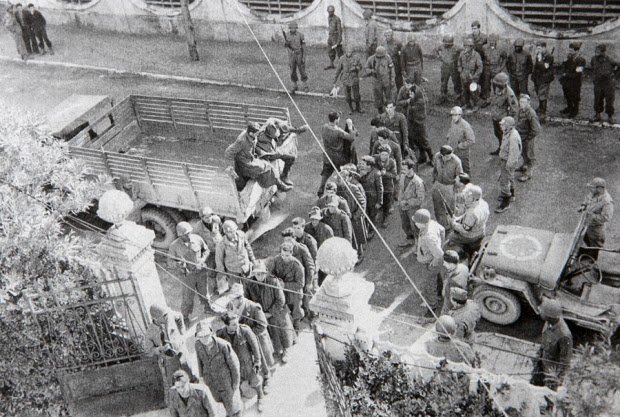
The events in Fornovo disrupted the German plan, as much by the disarray of their troops as by the delay it caused. This, added to the news of Adolf Hitler's death left the German Command in Italy with no option but to accept the surrender of its troops. 
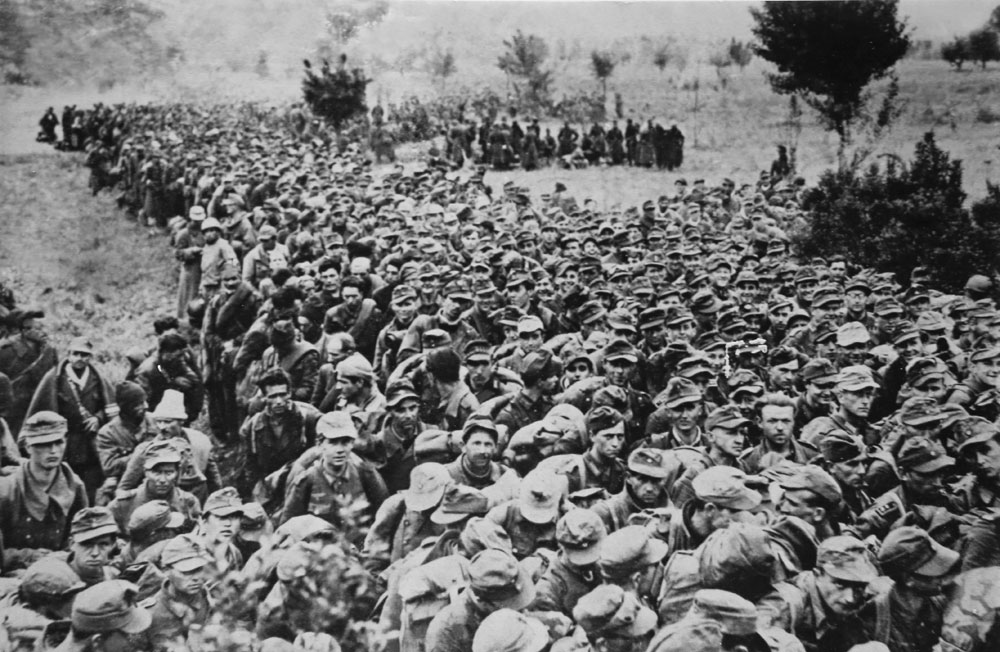
In their final advance, the Brazilians reached Turin and then on 2 May they joined up with French troops at the border in Susa. That same day brought the announcement of the end of hostilities in Italy. 

Among the 48 pilots of the Brazilian Unit of the Air Force who carried out war missions, there was a total of 22 losses; five of the pilots were killed by anti-aircraft fire, eight had their planes shot down and bailed out over enemy territory... 

... six had to give up flying operations on medical orders and three died in flying accidents. In all, the 1st Fighter Squadron flew a total of 445 missions, 2,550 individual sorties, and 5,465 combat flight hours, from November 11, 1944 to May 6, 1945.
On 22 April 1945, the three remaining flights took off at 5-minute intervals, starting at 8:30 AM, to destroy bridges, barges, and motorized vehicles in the San Benedetto region. At 10:00 AM, a flight took off for an armed reconnaissance mission south of Mantua.
They destroyed more than 80 tanks, trucks, and vehicles. By the end of the day, the Brazilian Squadron had flown 44 individual missions and destroyed hundreds of vehicles and barges. 

On this day Brazilians flew the most sorties of the war; consequently, Brazil commemorates April 22 as 'Brazilian Fighter Arm' Day.
The 1st Brazilian Fighter Squadron destroyed 1,304 motor-vehicles, 13 railway waggons, 8 armoured cars, 25 railway and highway bridges and 31 fuel tanks and munition depots.
Nickname: Due to the Brazilian dictatorship's unwillingness to get more deeply involved in the Allied war effort, by early 1943 a popular saying was: "It's more likely for a snake to smoke a pipe, than for the BEF to go the front and fight."
("Mais fácil uma cobra fumar um cachimbo, do que a FEB embarcar para o combate.")
Before the BEF entered combat, the expression "a cobra vai fumar" ("the snake will smoke") was often used in Brazil in a context similar to "when pigs fly".
As a result, the soldiers of the BEF called themselves Cobras Fumantes (literally, Smoking Snakes) and wore a divisional shoulder patch that showed a snake smoking a pipe. 
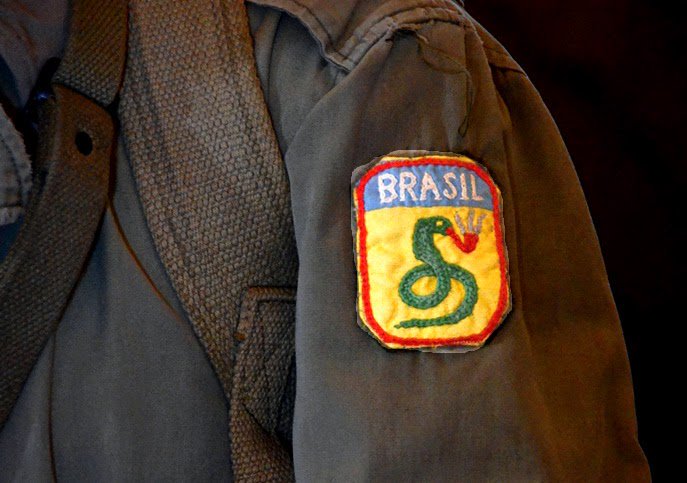
It was also common for Brazilian soldiers to write on their mortars, "The Snake is smoking ..." ("A cobra está fumando...").
the Second World War stole the lives of nearly 2.000 Brazilians. 
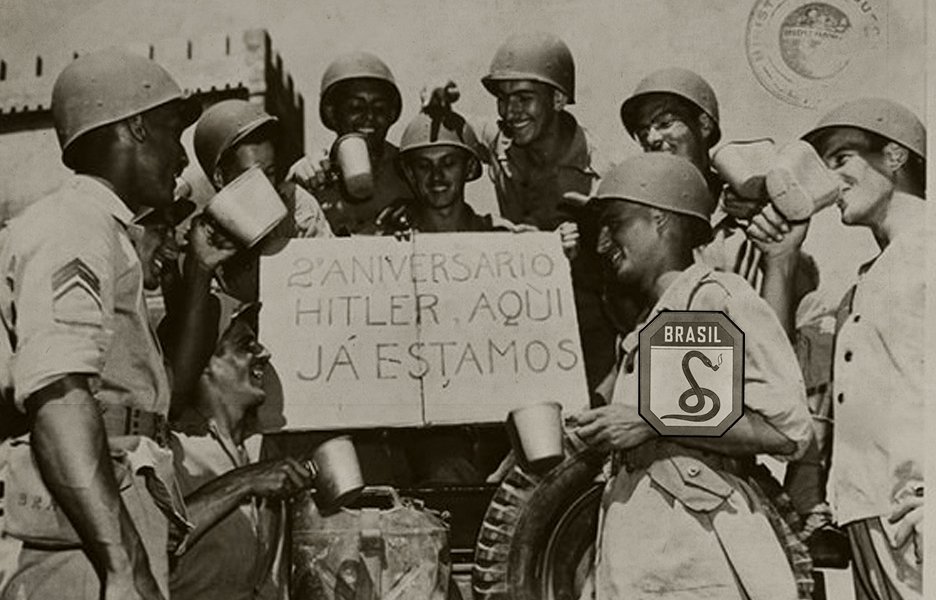
And here is my mug :) 

Aos Brasileiros chegando: eu também sou Brasileira, viu? :) dw.com/pt-br/a-brasil…
The Italians built several monuments as a tribute to the BEF. 

What is interesting (and scary) about the Brazilian soldiers is that practically none of them had military training and were taken from poor and humble cities and thrown directly aboard the ships that left for Italy.
So their first weeks in Italy were dedicated to training led by American soldiers - since they were much more experienced and technically prepared. Brazilian uniforms and equipment were also supplied by the US Army.
E aos brasileiros interessados, recomendo muitíssimo esse livro escrito pelo @RealBarone. A nova edição sai em breve! 

American soldiers in Natal - Brazil, during the war. 


• • •
Missing some Tweet in this thread? You can try to
force a refresh















